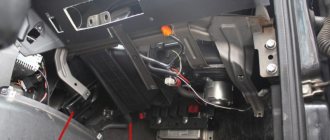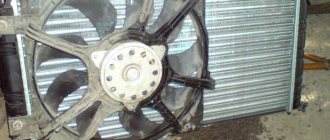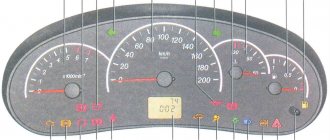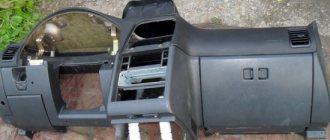Diagram and design of the heating system in the VAZ-2110
The heating unit itself is represented by several components:
- Electric motor. A ventilation device is fixed on it, designed to pump a hot air flow.
- A radiator device, the failure of which will lead to the inoperability of the stove. On old-style heating systems, the radiator assembly is not equipped with a valve designed to shut off the flow of coolant through the device. Therefore, the unit practically does not leak, since leaks are usually associated with the faucet. The absence of this element ensures the fastest heating of the car interior.
- Three dampers. One of them is designed to close and open the heating channel, the second is used for recirculation, and the third is necessary to control the heater.
- The resistor device is designed to regulate the blowing speed.
Components of the heating system
The main parts of the heating system for the interior of the VAZ 2110 car:
- 1 – electro-pneumatic valve device;
- 2 – front housing of the air intake of the heating unit;
- 3 – water deflector device, presented in the form of an air intake flap;
- 4 – valve device for controlling the damper of the air flow recirculation system;
- 5 – damper of the recirculation system;
- 6 – rear part of the air intake housing of the heating unit;
- 7 – heating channel damper;
- 8 – damper of the heating unit control system;
- 9 – radiator unit;
- 10 – protective plastic casing of the radiator device;
- 11 – bushing installed in the steam outlet pipe;
- 12 – bushing for the supply line of the heating unit;
- 13 – bushing of the outlet pipe;
- 14 – electric motor of the heating system;
- 15 – electric motor housing;
- 16 – supporting surface of the damper drive lever used to control the stove;
- 17 – drive handle for controlling the damper of the heating system;
- 18 – gear motor of the drive device, presented in small sizes;
- 19 – resistor element;
- 20 – protective cover for the heating unit lining.
Causes of malfunctions of the VAZ 2110 stove
The main reason for replacing the stove on a VAZ 2110 may be a malfunction of the heating system:
- radiator leakage;
- violation of the tightness of the connections of the pipes on the VAZ 2110 stove;
- faucet leak;
- interruptions in fan control;
- violation of the integrity of the wires;
- oxidation of electrical elements.
The price of repairs will directly depend on the timeliness of identifying these defects in the stove on the VAZ 2110. More serious damage will require a competent approach and drastic measures.
The cause of a coolant leak in the heating system can be a corroded radiator, faucet, or steel pipe. Correct diagnosis can only be made with a thorough visual examination. If there is a hidden malfunction of individual elements of the stove, they can simply be replaced, since today there are no difficulties in purchasing spare parts for VAZ.
One of the reasons for heater failure may be a decrease in the functional activity of the stove motor, regardless of the speed. In this situation, you should check whether the fuse for the VAZ 2110 stove has blown. If this defect is detected, it must be immediately replaced with a new one.
If the coolant circulation deteriorates, the culprit is a damaged heater tap or a blockage in the radiator itself. If the tap jams, it will need to be replaced, and in the second case, the radiator will need to be thoroughly cleaned.
Due to the obvious imperfection of the heating system, many decide to remake the stove on the VAZ 2110. Most car enthusiasts, relying on their own strength, try to improve the quality of its operation on their own, but as facts show, it is not always possible to achieve the desired result. Even with deep theoretical knowledge of how to remove the heater on a VAZ 2110, you can only improve the tightness of the joints of air ducts, nozzles, or redirect hot air flows.
But this step, in most cases, will not affect the temperature inside the cabin - it remains the same. To keep your car warm and comfortable in winter, you need to increase the volume of heat pumped by the radiator. Most often, the problem is a fan that is underpowered and unable to produce the required airflow. In this case, you will need to remove the stove on the VAZ 2110 to replace the electric fan.
Video “Guide to replacing the damper gear motor”
The channel In Sandro's Garage presented instructions for changing the damper gearmotor in a garage environment.
The standard stove on the VAZ 2110 car has minor drawbacks, such as it does not dry foggy windows well in rainy weather, and poor heating of the driver’s and passenger’s feet. But these shortcomings can be corrected with great desire and free time.
To do this you will need a small set of tools and inexpensive materials:
- A little soundproofing
- Polyurethane foam
- Plastic corrugation
- Coffee jar
- Modelin (anti-squeak material)
- Mesh from columns or something else for making a lattice
- Sewage pipe
- Tool set, screwdrivers, pliers, wrenches, metal (plastic) file
Refinement of the air duct system of the VAZ furnace, dismantling the standard installation
If you have a little time and desire, modifications to the VAZ 2110 stove can be done much more thoroughly, namely:
- sealing the cracks in the front panel of the torpedo air ducts;
- modernization of the car stove damper;
- modernization of the heating system for the rear seats and driver's feet, installation of corrugated heating ducts.
All this will certainly result in the desired result and significant heat transfer from the stove, but first you need to remove the dashboard along with the dashboard and heater air ducts, for which you need to:
- 1. Remove the floor tunnel lining cover and the interior heating air ducts of the VAZ 2110, and then the body itself, screwed with self-tapping screws to the bottom of your car;
- 2. To remove the instrument panel, you will first need to dismantle the glove box by unscrewing it from its hinges and turning off the glove box light;
- 3. Through the formed niche, unscrew the mounting bolts of the instrument panel;
- 4. Having unscrewed all the fastening screws of the panel in its upper and lower parts, as well as on the controller bracket, we can finally remove the instrument panel from the mounting studs;
- 5. In order to remove the panel from the car interior, you will need to disconnect the electrical connectors for connecting the devices.
Improvement and tuning of the dashboard on the VAZ 2110
One of the most popular ways to improve the dashboard on a VAZ 2110 is its sound insulation. In order to do this, you must perform the following steps:
- We remove the tidy, I already told you how to do this earlier
- Next we foam, but under no circumstances should you pile up a huge pile of foam at once, it won’t dry out in a week.
- Don’t forget to try it on so that later it doesn’t turn out that your steering wheel touches it, or it’s just too high.
- In principle, all the work consists of two things, you cut, foam, cut again and so on many times.
- Next, we apply the cheapest putty we could find.
- Next we cover the dashboard with Shumka.
- We install the torpedo back.
You can modify the dashboard of a VAZ 2110 in different ways, someone covers it with leather, someone inserts an LCD monitor into it, in tuning a car it all depends on you and your fantasies and desires.
VAZ 2110 heater blows cold, why?
Many owners of “ten” complain that at some point the stove constantly blows cold air and no amount of turning the handles of the automatic heater control system can save the situation. There can be a lot of problems and malfunctions. For example, the ACS controller itself is faulty, the ceiling sensor or micro-geared motor is faulty and simply does not open or close the damper. Another reason is the air (air lock) in the heater radiator, which is simply not capable of heating the air passing through it. Below is a schematic representation of the VAZ 2110 heater device .
Heater dampers VAZ 2110
Often the cause of poor performance of the “tens” heater is the damper of the VAZ 2110 heater . The damper may not close tightly or open poorly. The heater flap itself is made of plastic, which can become warped and perform poorly over time. Many car owners buy a metal damper and change it themselves. How to check the functionality and evaluate the condition of the heater damper? Everything is quite simple, remove the central air duct deflector and there you have it - a damper! Let's look at the photo.
Repair
If you are planning a major overhaul of the stove, especially if you still have an outdated system, start by purchasing a new stove radiator (it is better to buy a copper one, it heats much better), and this will only improve the performance of the heater.
But the design of the VAZ injector stove is practically no different from carburetor cars.
- The engine block has a plug from which antifreeze is drained into some container;
- The frill is moved forward a little (a lengthy operation), the windshield wipers and everything that gets in the way are removed;
- The heater housing is removed. You should know that the body is divided into two parts. The front one is removed along with the fan;
- Next comes the cabin filter housing. It can be changed at the same time;
- The other part of the fan housing is removed;
- The clamps are loosened, the hoses are removed;
Heater Air Ducts and Control Parts
1 – rear heating air ducts 2 – floor tunnel lining 3 – foot heating ducts 4 – central cabin ventilation nozzles 5 – side cabin ventilation nozzles 6 – front door window heating nozzles 7 – interior heating system control lever 8 – air distributor housing 9 – damper foot heating 10 – windshield heating flap 11 – heater
Heater parts
1 – electro-pneumatic valve 2 – front heater air intake housing 3 – air intake water deflector flap 4 – recirculation damper control valve 5 – air intake recirculation damper 6 – rear heater air intake housing 7 – heater duct damper 8 – heater control damper 9 – radiator 10 – heater radiator casing 11 – steam exhaust hose fitting 12 – supply hose fitting 13 – exhaust hose fitting 14 – heater electric motor with fan 15 – electric motor housing 16 – support platform for the heater control damper drive lever 17 – heater control damper drive lever 18 – damper drive micromotor 19 – resistor 20 – heater casing cover
Interior ventilation of the VAZ 2110 is supply and exhaust: air is supplied into the cabin through holes in the windshield trim (spontaneously - when the car is moving, or forced - when the heater fan is operating) and exits through the cracks between the upholstery and the inner door panels and then through the holes in the ends doors. These holes have valves that allow air to come out, but prevent it from getting inside the car. This design improves the thermal insulation of the cabin.
The air entering the cabin is heated, if necessary, by passing through the VAZ 2110 heater radiator, and is distributed in accordance with the position of the air flow control handle. The main part of the air is directed to the windshield and - through deflectors blocked by flaps - to the side windows and to the central part of the cabin. Air is also supplied to the feet of the driver and the passenger sitting in front through two pairs of deflectors (one pair at knee level, the other at the floor) and to the feet of rear passengers through the lining on the floor tunnel and two air ducts under the front seats.
To speed up the heating of the cabin and prevent the entry of outside air into the cabin (when crossing gas-filled, smoky, dusty sections of the road), an air recirculation system is used. When the recirculation button is pressed down (on the instrument panel), the electro-pneumatic valve opens, and under the influence of vacuum in the intake manifold, the recirculation system flap blocks the access of outside air to the car interior. Thus, the recirculation system can only operate when the engine is running. At the same time, if the fan is turned on, the air in the VAZ 2112 cabin continues to circulate, passing through the heater air ducts.
The fan has three operating modes: low speed, medium and automatic speed selection (determined by the control unit). The fan electric motor is a commutator, DC, with excitation from permanent magnets. The current consumption at maximum speed is 14 A. Depending on the selected speed, the VAZ 2112 electric motor is connected to the vehicle’s on-board network directly (maximum speed) or through an additional resistor. The latter has two spirals with a resistance of 0.23 Ohm and 0.82 Ohm. If both spirals are included in the circuit, the fan rotates at low speed, if only one (0.23 Ohm) rotates at medium speed.
It is not recommended to press the fan wheel from the electric motor shaft - this can upset the balancing. The electric motor cannot be repaired (except for cleaning the commutator); if it fails, it should be replaced as an assembly with the fan wheel.
The heater radiator is installed horizontally under the instrument panel of the VAZ 2110 in a plastic casing and consists of two plastic tanks (the left one with a steam outlet fitting) and two rows of aluminum tubes with pressed plates. Depending on the position of the dampers, part of the intake air passes through the radiator (in the extreme positions of the dampers all the air passes or does not pass at all), while the rest of it bypasses the radiator. Unlike previous VAZ models, there is no valve to shut off the flow of coolant, so the heater radiator is always heated when the engine is running. This design ensures low inertia of the VAZ 2111 system (the set air temperature is reached faster) and the absence of leaks associated with faucet leaks.
The heater is controlled by commands from the electronic control unit. The air temperature in the cabin is set by setting the controller knob (temperature setter) to the appropriate scale division (from 16°C to 30°C, with an interval of 2°C). The unit reads information about the temperature in the cabin from a temperature sensor located on the ceiling and equipped with a microfan. Then - depending on the temperature difference - it turns on the micromotor that controls the heater dampers and selects the fan rotation speed if the fan control knob is set to position “A”. The micromotor is equipped with a VAZ 2112 heater damper position sensor (ring resistor). The signal from the sensor is sent to the control unit, which turns off the micromotor as soon as the damper reaches the set position.
To fine-tune the control unit, it has an adjusting screw. To check the accuracy of temperature control, close all doors and windows, place a control thermometer next to the temperature sensor, set the fan control knob to position A, and set the temperature dial 2 ° C above the temperature in the cabin measured by the thermometer. If after 15 minutes the actual temperature in the cabin does not correspond to the set one, remove the controller from the socket and turn the adjusting screw clockwise to increase the temperature and counterclockwise to decrease it. After adjustment, check the operation of the control unit again.
The control unit, temperature sensor with microfan VAZ 2111, micromotor and heater damper position sensor are not repairable and must be replaced with new ones if they fail.











